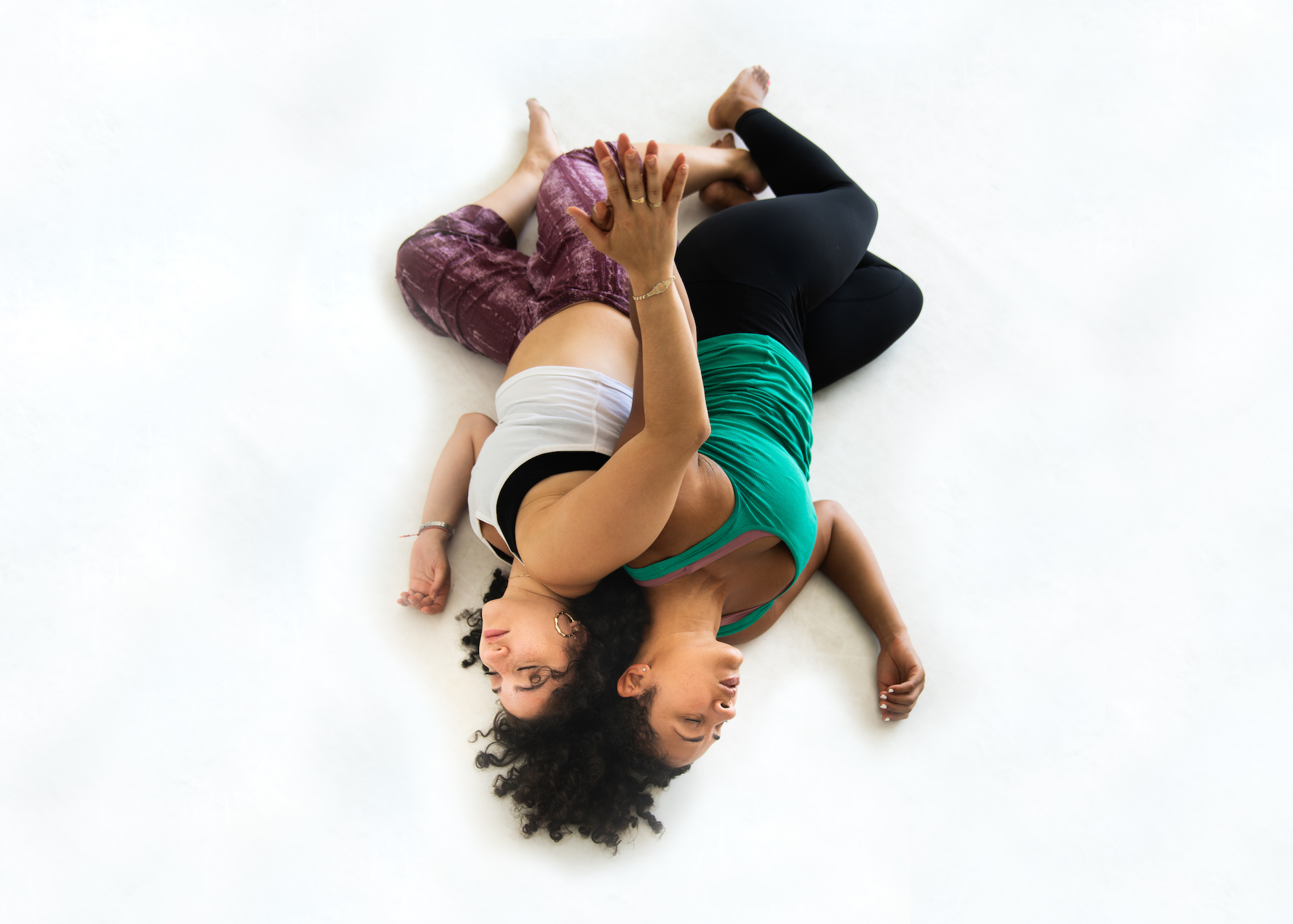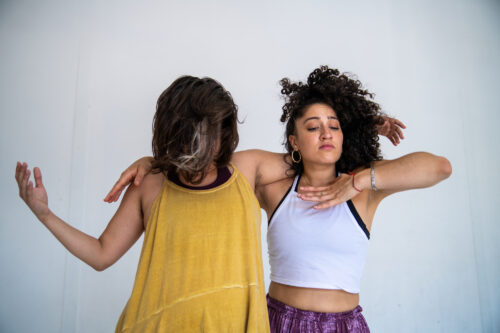The Body as a Vessel Transitions from Passive Object to Active Process: DIVERSEWORKS presents Marina Magalhães’s WOMB, a project of BODY AS A CROSSROADS

Bianca Medina and Tatiana Zamir in rehearsal for Body as a Crossroads. Photo by Bobby Gordon.
DiverseWorks presents Marina Magalhães’s Womb, a project of Body as a Crossroads on April 21 and 22 at 7 pm at MATCH. Womb lives in the sacred meeting space of dualities that Magalhães and her collaorators Bianca Medina and Tatiana Zamir refer to as “vesseling,” wherein it is possible to conjure spirit through flesh, find joy in grief, and create ritual out of rapture. Womb was born out of Magalhães’s personal experience of a missing miscarriage amid the global COVID-19 pandemic and quarantine, and her intensive process of finding a way to return to her body and to her embodiment practice after an extensive period of grief and loss. Womb is also greatly informed by the Afro-Latin diasporic dances from her history as a Brazilian dance practitioner, especially the Orisha dance rituals of her youth. It was a privilege to speak with Magalhães about the experiences and vesseling practices that inform this important work.
AT: Could you tell me a bit about what inspired this work?
MM: This work emerged from two pregnancy losses I experienced in the height of the COVID pandemic and lockdown. Because of how intensely long the first pregnancy loss in particular too, it fundamentally changed my relationship with my body in a way that felt completely unprecedented for me. Especially as a dancer my whole life and someone who really understands myself through my body and movement, this was such a large rupture.

Marina Magalhães in rehearsal for Body as a Crossroads. Photo by Bobby Gordon.
I got approached by DiverseWorks while I was going through this experience. I started re-entering my body practice which had really put on pause first as a result of pandemic but in this much more traumatic way as a result of the miscarriage. I found that experience of embodied grief was impossible to ignore and kept rearing itself in the studio and wanting to integrate with this opportunity. What I had in June is medically called a missed miscarriage which is when the fetus dies inside the womb but the body doesn’t recognize it right away. Often what we understand from miscarriage is some blood on the underwear. Things happen but you don’t see the physical process of it. That’s all I knew of miscarriage. What happens in my experience, which is quite common, was going to the doctor and trying to find a heartbeat and not being able to. This was around ten weeks this happened. It was height of pandemic, pre-vaccine. I was reticent to go to the hospital if I didn’t need to. There was the option of doing this naturally and waiting for my body to catch up with reality and miscarry on my own at home, which was what I chose to do. But what that ended up meaning was I was living in this limbo between life and death much longer than I had anticipated. It took my body four weeks to recognize I was miscarrying. It was such a profound state of uncertainty and being caught between life and death in this extremely embodied way. I felt so present to the truth of carrying death inside of me for that long. The very physical experience of bleeding and miscarrying and going through a birth experience but what you’re giving birth to is death. That was deeply transformative for me. After I miscarried – the actual active bleeding process – it’s normal for the body to bleed up to two or three weeks, like a very light period, but my bleeding lasted ten weeks. From the time that I found about the miscarriage to the day I finally stopped bleeding it had been about four months. It was the most visceral experience of grief I have experienced in my life and the closest I’ve come in contact with death in a personal and embodied kind of way.
What I think is interesting about this project is that prior to this happening I had started building this research of body as a crossroads which emerged from my MFA thesis in 2018. I graduated in 2019. What I kept gravitating towards in that research was improvisational practice as a technology for remembering things that we often feel disconnected from as a result of the modern circumstances that we live in. This comes from a context of my own life experience for somebody who is an immigrant and grew up nomadic. I’ve always had this sense of having to navigate a lot of multiplicities, multiple verbal languages within multiple embodied languages, and code switching. Something I started to be interested in was this idea of the body as a crossroads for where so much of these negotiations and intersections live in and get stored in. We think of ancestral wisdom that we carry inside of our bodies. Our bodies can be a crossroads of a way of knowing that we can access. I mean something as simple as breath. Our breath lives in cycles and it reminds us that we are inherently cyclical beings. It reminds us we have a connection to everything else that is cyclical in this world. To the waves and the ocean, the cycles of the moon. There’s so much mirroring present in our bodies. This is something that so many cultural and ancestral traditions have known for a long time. This is very ancient knowledge that we have devalued and minimized and committed genocide against. I was leaning into this research prior to these miscarriage experiences. What I kept gravitating towards as a way of unearthing this embodied knowing was improvisational dance practice. There was something about entering a space of not knowing, of not planning, of allowing yourself to become open and listen for what wants to come through and what is here that felt extremely compelling. The unlocking of this deep well of story, of knowledge.
I had been experimenting with improvisation in a really intentional and deep way prior to this experience. Then this experience happened where I inhabited that space of uncertainty on such a completely different dimension than I had ever experienced. In some way it felt almost ecstatic. When I would enter that space of holding space for my grief and allowing myself to take the time that I needed to recover. I didn’t reenter the world for six months. I was in a deep space of internal healing and processing. So much of what I was doing was allowing myself to be still and heavy and slow. There was something deeply nourishing about that, and deeply pleasurable that felt really bone deep inside of me. As I started working on this piece and getting into the studio with collaborators and seeing what was this movement language that wanted to emerge, it kept being this improvisational practice where we would create containers and allow ourselves to listen. To listen with slowness. When I say slowness, it works on a few levels. There’s the physical level of moving slowly but also time slows down and you’re able to attune to things in a very different way and you notice and you hear and you sense things in a different way.
This dance practice, this improvisational practice I’m talking about, my collaborators and I have been calling it vesseling. It’s a word that emerged organically from conversations I was having with Bianca Medina, one of my core collaborators. In my MFA process, she was integral and accompanied a lot of that journey with me. In the beginning stages of talking about these ideas and experimenting with our bodies, we kept using the word vessel. I kept thinking of the body as a vessel for all of this to flow through but also a vessel is a passive object and there was something active about what we were doing, that had its own agency. Vesseling became this word that captured that duality – being the vessel but also vesseling through something yourself. I’ll say that idea for us was informed by our long-term practice in different Afro-Latin diasporic forms, specifically Orisha dance. Orishas are deities of the West African pantheon. They’re present throughout the Americas in various different religions, in Brazil, Cuba, and Haiti. They signify different archetypal characters and elements of nature. The way that you worship Orisha is through dance and song. It’s a very embodied practice of worship. I was first introduced to Orisha through my family. I’m from Brazil. Growing up, there was always iconography or references to Orisha in our lives in a very indirect way. It wasn’t until I started dancing and gravitating towards dance forms that felt connected to my culture and the cultures I grew up in that I started to develop these forms in more depth and with more rigor. I give a lot of credit to my dance teachers from Brazil, Vera Passos and Rosangela Silvestre, two visionary choreographers really investigating how tradition lives in our contemporary lives and they directly work with Orisha dances and songs and practices within their choreographic work and pedagogical work. The way that you worship Orisha inside of the tradition is you become embodied by the spirit. There’s different language around that. Some call it being possessed but that doesn’t have the same vibration as I understand it as. I liked to say that you become mounted by spirit. That energy of opening yourself to getting mounted by energy, by Spirit, by something, is something we see all the time. This is something my teachers talk about, too. When we enter a place of deep focus, deep attention, there is a surrendering that happens that allows us to become attuned to something that feels beyond ourselves but also intrinsically connected to ourselves. Through Bianca and I having these conversations, and reflecting on our dance education with these forms, and how they inform our own contemporary dance practice, we started to get present to vesseling as an energy we see around us all the time. When people enter that space of deep listening, of deep remembering. It’s surrender but also focus. You have to have both in order for that vibration to happen. That’s where that word and language starting to come in for us.

Bianca Medina and Tatiana Zamir in rehearsal for Body as a Crossroads. Photo by Bobby Gordon.
This work we’re sharing was born out of our vesseling practice. What that’s translating into is that a lot of the show is itself improvisational. A lot of it is in the moment and doesn’t happen again. Nothing repeats itself twice in the same way because it is improvisational. Other parts of the show are born of the practice, but we have played with some sense of structure and some sense of degrees of certainty. We flow in the spectrum of how much are we in a place of uncertainty and how much do we know. At least half is entirely improvisational. The show is titled WOMB, which feels apt for me in this experience that I’ve had with my womb and the womb signifying such a clear place where cycles live and where uncertainty lives and where mystery lives. When I use those words they can have sort of a sweet feeling but there is a real edge, a tension, inside of those things when we lean in and inhabit and have to grapple with them.
AT: When you were waiting for the miscarriage, were you trying to grieve in order to let go, or embodying any sort of movement practice in order to move through that practice?
MM: This was in June of 2020, the height of lockdown and shelter in place. I wasn’t leaving the house because of COVID and also because I entered a pretty deep depression. I became what I felt was completely disconnected from my body. I wasn’t doing anything that felt intentional or trying to move towards healing or processing. I am thankful I was working with a midwife prior to the miscarriage who is a friend of mine. She continued being my midwife through the miscarriage, so she would come over and do a few visits with me in person and helped hold space for me. She was midwifing through that process. I was still giving birth to something, but something very different than we had planned or hoped for. That time period I was waiting was the darkest period of my life. I felt disconnected from my body and my dance practice, any kind of creative nature. The experience of loss – I lost something, something died inside of me – was very real and visceral. It took a long time to re-enter my body and movement. There was a time period I didn’t think I would dance again. It was a pretty profound depression.
AT: What have these vesseling sessions been like and has it been emotionally difficult for you to reenter the space of the body and how have you worked through that?
MM: It’s been extremely emotional. Bianca moved to New York a couple of years ago right before the pandemic. My other collaborator, Tatiana [Zamir], was also living outside of LA. It started out remotely and we were doing a lot of Zoom conversations. The first two months of our process we spent two weeks in each element: earth, water, fire, air. The prompt was to listen to how these elements are showing up in our lives and how our bodies are wanting to embody them and respond to them, how we’re resisting them, how they’re feeding us, how they’re challenging us. If they’re showing up beyond the body in other ways. We started with that. It sounds like it could be fairly unemotional, but even that felt like quite a personal investigation. When we started the earth element, I was still bleeding from my second miscarriage, which was a much shorter miscarriage and a very different experience from my first. But I was still bleeding and when I was tuning into this earth element for those couple of weeks, I wrote a poem reflection. What was coming through for me were these words and poetry. It was this poem that said Earth is a fellow grieving mother. That was how I was able to relate to her and to that energy. We finally got in person together in June. Because we’ve been far away from each other, we’ve been doing these concentrated two-week residencies. We did one in June. We did one in September in Houston, and we did another one in January in LA and we just finished our last one here in LA last week. These concentrated time periods have been wombs in and of themselves. They’ve been little bubbles we’ve gone into where we really live in this practice. A lot of what I’ve shared so far feels sad and heavy but we have so many moments of lightness and humor and joy that have come through in this practice and if anything, we’ve become really in tune to how close together all of those experiences are. These things we feel are seemingly opposite or at odds with each other are so interconnected and so related and dependent on each other. Which isn’t a new idea. To be experiencing it in the body quite as viscerally the way that we have has been a deepening of that learning, for sure.
AT: In terms of the improvisational aspect, that means that there will be an improvisational aspect that happens in the performance. Is that happening from music, or is there an understanding that you’ll move thinking about these elements at the same time? How is that working with the performance itself?
MM: There are different containers that we have set for them. That’s the frame we use for these improvisations. What is the container that’s holding it? The container can be very minimal or super structured. The containers differ. One improvisation the container lives inside of how we begin, and a prompt that we know but that we don’t share with the audience. That guides us. We don’t know how it evolves or where it ends. Or when it ends, even. One container we’ve explored emerges from soundscapes. The sound designer I’m working with, Avila Santo, phrased it perfectly when he said, “I’m thinking of sound in this piece as space, as texture.” We get to play and live inside of it. There’s a poet that’s played a large part in our process so far. She’s from Arizona. Her name is Natalie Diaz.
AT: Oh yeah, I love her work.
MM: Postcolonial Love Poem. We’ve been reading it very closely this past year. Certain lines from different poems that we have worked with internally as prompts for improvisations. Another improvisation in the show is guided by two of her prompts.
AT: In terms of the part of the performance that is not improvisational, did the three of you collaborate to choreograph together?
MM: It’s been degrees of collaboration as well. There’s one piece in the show which is the most choreographed. The base phrase for it is something that I generated in one of our residencies and taught to Bianca and Tatiana. I had a vision for how to structure it and how to set that choreographically. Then there’s another phrase in that piece which are phrases that they each created that bleed into each other. They generated these phrases using the same process I used to generate my phrase, but they didn’t teach it to the trio. That one just so happened, the very first time that they shared it, they shared it at the same time. It’s perfect. I haven’t changed almost any part of it. Even that has an improvisational nature but we decided to keep it. Something we’ve been doing internally is rethinking how we language our roles inside of the work because so much of it is improvisational. It doesn’t feel accurate to say I am the choreographer because the choreography is actually being created in response and on the spot by all three of us. The structures, the motifs, all the things we associate with choreography, are emerging in the moment by all three of us and whatever it is we are attuning to. There’s something about this project that feels like it’s inquiring –not just about the content – but around form. How do we talk about dance? How do we language dance? How do we navigate or create dance?

Marina Magalhães in rehearsal for Body as a Crossroads. Photo by Bobby Gordon.
AT: Using the word “womb” is so interesting also. Instead of thinking about the child or the fetus, it’s thinking about the vessel or the container. Even the way you said that Avila Santo would describe sound as space or texture, it’s also the way a fetus would respond within the womb to sound. As space rather than what we think of as sequential music. Are there any specific costumes for this piece?
MM: Our costume designer is Elida Barry-Donat who is based in New York. On top of Elida’s designs we are collaborating with Anthony Suber, a Houston-based visual artist and sculptor who creates wearable sculpture. When I visited Houston for the first time in June, he and I really connected around a lot of these ideas and it seemed to echo a lot of the ideas he works with, especially around ancestral memory and how that shows up in modern present life, the relationship to futurity, the cycles of time. He’s creating three wearable pieces, one for each of us, which we will activate in this show. We’re also doing a performance activation of his gallery exhibit at Redbud Gallery in Houston, on April 12th, which will center around his work. That’ll be entirely a vesseling practice activating his pieces in the gallery space.
AT: Can you say more about the costumes being made by Elida?
MM: In my conversations with Elida, we talked about womb colors. When I say womb, I’m saying it as shorthand for womb space. Yes, it’s connected to this anatomical part of us, it’s also this energetic space that we go into. So I’ve been talking with Elida about womb colors, the colors of the spectrum of how we bleed. There’s that deep red, bright red, maroon/brownish red. The color palette is constructed from of those womb colors. The fabric that she is using feels light and movable, but I wouldn’t say it visually restricts or drives the dancing.
AT: Those colors around bleeding are interesting, too, because each color signifies so many different things. Has Tatiana had the same history with you as Bianca?
MM: This is our first time collaborating on performance together. We’ve been friends and colleagues for a long time. We’ve shared artistic space and curation together. This is our first time working inside of a performance together. I admire her work. Vesseling isn’t something Bianca and I feel like we’re creating, but that we’re noticing. We see this vesseling energy as an ancient practice, something we recognize in a lot of the dance practices we’re trained in but beyond dance. It’s an energetic exchange that people go into in all kinds of ways. We’ll go see a performance and say, “Oh that person was hard-core vesseling.” We’re able to recognize it outside of ourselves. The impetus in inviting Tatiana to the work was that I saw a dance film that she created. In the film that I saw, she danced in it and conceived of it and created it. I had that recognition that she’s vesseling inside of this. This energetic space she already knows and that her body is in conversation with and inhabiting. That just felt aligned.
There’s one more collaborator in the work. His name is Francis Almendárez, who is a local Houston-based filmmaker. When we came in September to Houston, we connected with Francis. One of the ways I was interested in being in Houston was to be in conversation with the land in a site-specific way. He helped us think of different places to go to in Houston to hold our vesseling practice in those places. He brought his camera and filmed it. We went to Galveston the day before the hurricane hit, and it was so windy. We went to a park. Some of his videography is also going to be part of the piece, projected during the performance.
DiverseWorks presents Marina Magalhães’ Womb, a project of Body as a Crossroads on April 21 and 22, 2022 at MATCH. Tickets and more information are available at diverseworks.org.



Recent Comments